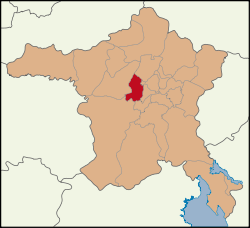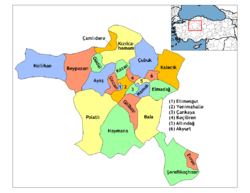Sincan, Ankara
| Sincan | |
|---|---|
| District | |
 | |
 | |
 Sincan | |
| Coordinates: 39°58′N 32°35′E / 39.967°N 32.583°E | |
| Country |
|
| Region | Central Anatolia |
| Province | Ankara |
| Government | |
| • Governor | Ertan Yüksel |
| • Mayor | Mustafa Tuna (AKP) |
| Area[1] | |
| • District | 344.26 km2 (132.92 sq mi) |
| Elevation | 855 m (2,805 ft) |
| Population (2012)[2] | |
| • Urban | 479,454 |
| • District | 479,454 |
| • District Density | 1,400/km2 (3,600/sq mi) |
| Time zone | EET (UTC+2) |
| • Summer (DST) | EEST (UTC+3) |
| Postal code | 06930 |
| Area code(s) | 0312 |
| Licence plate | 06 |
| Website | www.sincan.gov.tr |
Sincan is a metropolitan district of Ankara Province in the Central Anatolia region of Turkey, a large suburban town 27 km from the city of Ankara. According to 2010 census, the population of Sincan is 456,420 [3][4] The district covers an area of 344 km2 (133 sq mi),[5] and the average elevation is 855 m (2,805 ft). Sincan has friendly relations with the municipality of Doboj Jug from Bosnia and Herzegovina.
Geography
Sincan stands on a plain surrounded by hills and watered by the Ankara River, a tributary of the Sakarya River. There is some agriculture and light industry in Sincan, but the majority of people commute to Ankara by rail.
The symbol of the municipality is the tulip. The central square is called Lale Meydanı (Turkish for "tulip square"), and every year a tulip festival is held where plastic tulips are handed out in the streets.
History
Even prior to the period of the Ottoman Empire, a village stood in this location, which subsequently grew to when Mustafa Kemal Atatürk commissioned a housing project here for Turkish refugees from Romania and Bulgaria.
In recent years, Sincan has grown enormously with rapid immigration from many rural areas of Turkey. The town has especially attracted those with an aggressive conservative and religious outlook, thus Sincan is a stronghold for right-wing clubs, Islamic sects, and Islamist political parties. This was brought to light most famously in the political crisis of February 1997, when tanks rolled through the district (presumably as a warning to the people to respect the pressure being applied to the Islamist government of the time). More recent incidents include the pouring of green paint over the statue of Atatürk in the central square.
Well-known residents
- Şafak Sezer, actor and comedian
- Sinan Şamil Sam, professional boxer
- Abdürrahim Karakoç, poet
- Oğuz Yılmaz, folk musician
See also
- 1997 Turkish coup d'état
Notes
- ↑ "Area of regions (including lakes), km²". Regional Statistics Database. Turkish Statistical Institute. 2002. Retrieved 2013-03-05.
- ↑ "Population of province/district centers and towns/villages by districts - 2012". Address Based Population Registration System (ABPRS) Database. Turkish Statistical Institute. Retrieved 2013-02-27.
- ↑ Statistical Institute
- ↑ GeoHive. "Statistical information on Turkey's administrative units" (in English). Retrieved 2008-03-31.
- ↑ Statoids. "Statistical information on districts of Turkey" (in English). Retrieved 2008-05-04.
References
- Falling Rain Genomics, Inc. "Geographical information on Sincan, Turkey" (in English). Retrieved 2008-03-31.
- Municipality of Sincan, Turkey. "General information on Sincan, Ankara" (in Turkish). Archived from the original on 2008-03-23. Retrieved 2008-03-31.
External links
- District governor's official website (Turkish)
- District municipality's official website (Turkish)
- Local news website (Turkish)
- Local guides website (Turkish)
- Local Business website (Turkish)
| |||||||||||||||||||||||||||||||||||||||||||||||||||
Coordinates: 39°57′34″N 32°34′36″E / 39.95944°N 32.57667°E
